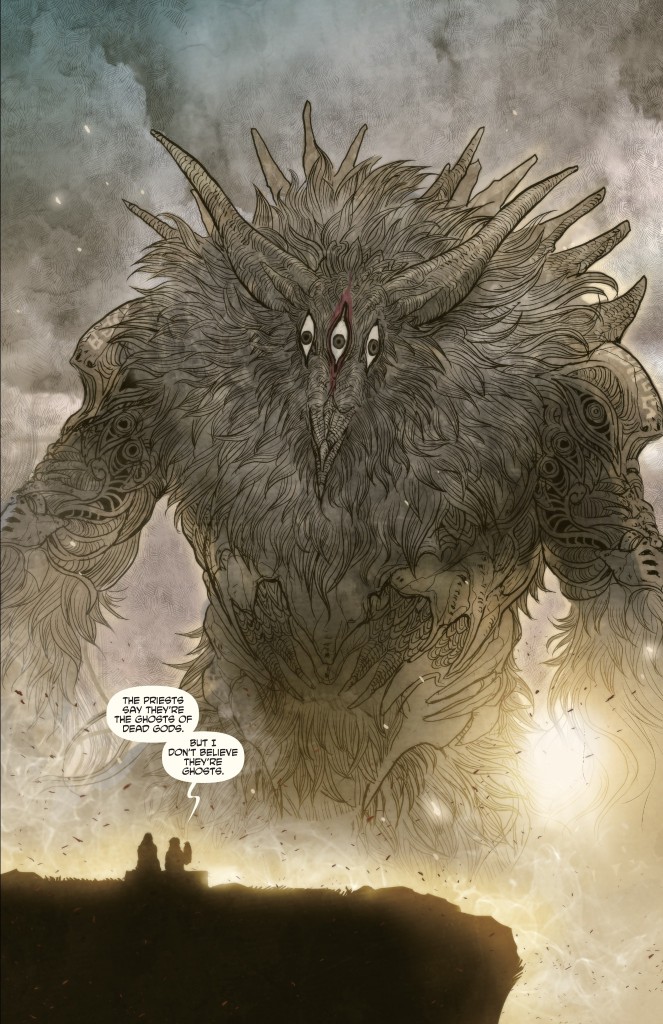
From Monstress. Artwork by Sana Takeda
I didn’t get into comics for the artwork.
No, at twenty-one, when I first wandered into a comic book store, I showed up as a lifelong reader of books, with a passion for well-formed stories, likable characters, and good writing. When my eyes scanned across the glossy pages of the first issue of Buffy: Season 8, I wasn’t looking at the artwork as much as I was focusing on those little dialogue bubbles.
Which, in retrospect, is a real shame.
Fortunately, the more comics I read, the more I began to look beyond those dialogue bubbles. A whole new world was opened up to me, filled with unique, and personal styles. Some were hyper-realistic, while others were more stylized. Some titles featured dark and gritty artwork, while others displayed bright and colorful illustrations. Over time, I grew to understand how a really talented artist could take a comic to a whole new level, and a less then talented one could actually damage a reading experience.
Another thing I discovered was that many of these great artists were also women. As someone who is passionate about supporting women in the media I enjoy, cobbling together a list of favorite female artists was only natural. You may notice that this list doesn’t contain any children’s comics, or manga. Obviously, there are amazing women writing in both fields — so much so that I could write an entire column on each — but to keep the length from getting too out of control, I decided a narrower focus would be more beneficial.
But enough jibber-jabber. Let’s get on to the good stuff! Just keep in mind that some of that good stuff is a little NSFW. But if a little nudity and gore doesn’t bother you, then push on ahead!
Artist: Fiona Staples
Comic: Saga
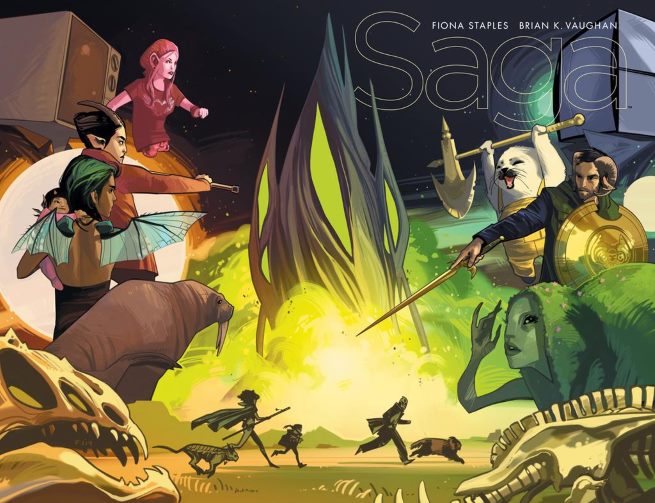
From Saga. Artwork by Fiona Staples
If I could pick one word to describe the sci-fi epic, Saga, it would be “bizarre.” And I mean that in the most positive, fangirlish way possible. As a result, the characters designs are some of the most unique in comics. And yes, those characters may come from the weird mind of writer Brian K. Vaughan, but if there’s one thing that artist Fiona Staples is good at, it’s tackling the weird. It doesn’t matter how many curve balls Vaughan throws her way, she can be trusted to knock it out of the park every single time. Even more impressive, regardless of how alien some of these creatures may look, Staples never loses sight of their — for lack of better word — humanity. She has a gift for portraying expression, and that extends to the characters whose facial features aren’t entirely human. Just take a look at the TV-headed robots and The Stalk with her spider-like eyes.
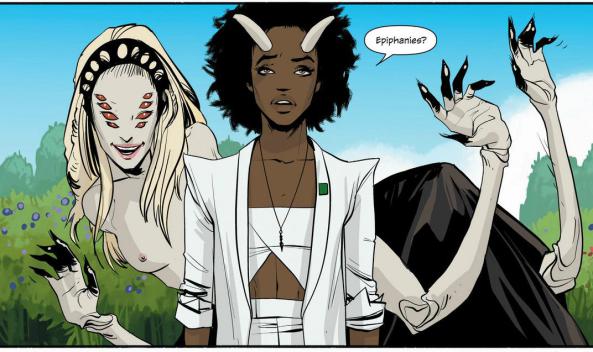
From Saga. Artwork by Fiona Staples
It’s also worth noting that on top of drawing Saga, Fiona Staples is also responsible for inking and coloring the comic, making the art entirely her own. As of the writing of this column, Saga has delivered close to 40 issues of high quality content, and has developed a real strong fan following. I can’t imagine that following would be anywhere near as strong had it not been for the amazing work of Fiona Staples.
Artist: Sana Takeda
Comic: Monstress
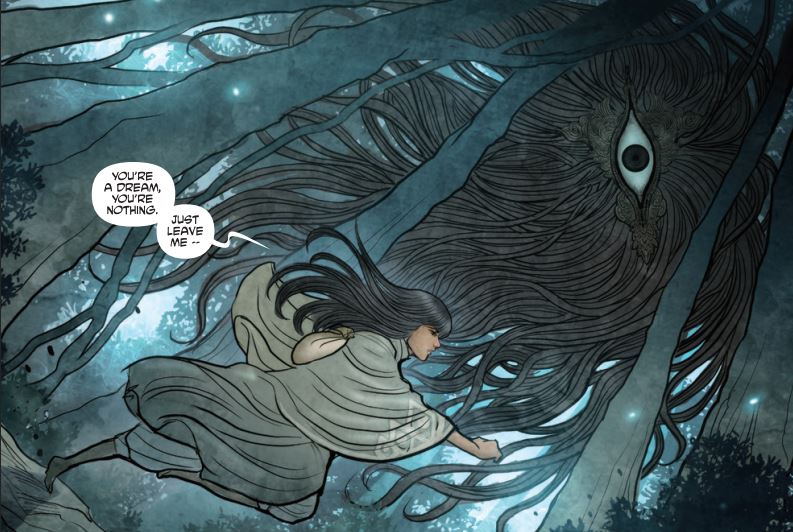
From Monstress. Artwork by Sana Takeda
I first encountered Sana Takeda’s artwork during her run on X-23. At that time, I couldn’t help but gawp over how pretty it was. But it’s not until you see that “pretty” style shown in contrast to horror that you really feel its full effect.
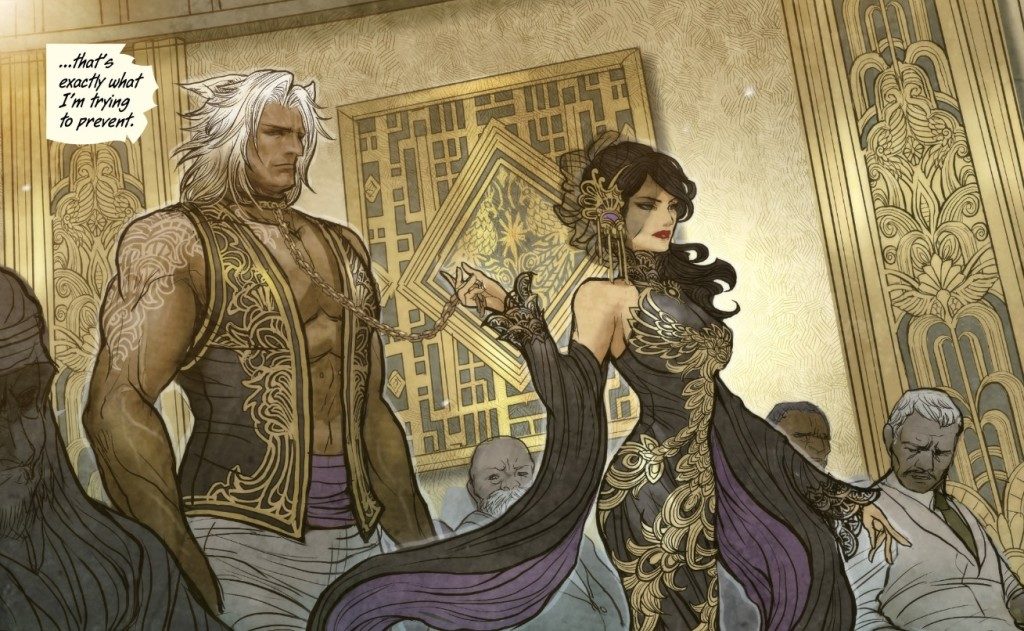
From Monstress. Artwork by Sana Takeda
Monstress is a dark, daaaaark comic with horrible things happening in every issue (including the torture and dismemberment of children). As a result, it’s not a title I feel comfortable recommending to a lot of people, but that doesn’t take away from how freaking amazing it is. And a big part of that amazingness is Sana Takeda’s artwork. Sure, Takeda’s style was pretty in a superhero comic, but in this grimdark fantasy setting, she’s really allowed to cut loose. Takeda skilfully takes wonderfully detailed backgrounds, and combines them with gorgeous character designs that run the gambit from beautiful, dark haired women, to Lovecraftian horrors, to chibi-style sidekicks. Monstress is a relatively new comic compared to others on this list, but it’s already made quite the splash. I can only imagine what could happen if artist Takeda and writer Marjorie M. Liu are able to keep this up for a Saga-length run.
Artist: Sara Pichelli
Comic: Ultimate Spider-Man

From Ultimate Spider-Man. Artwork by Sara Pichelli
Sara Pichelli is a slightly different choice then the first two artists on this list, because while Staples and Takeda are the only artists on their respective comics, Pichelli is one of many who has does artwork for Ultimate Spider-Man (which later became Miles Morales: The Ultimate Spider-Man, and then just Spider-Man, because the big two like to keep things as confusing as possible). In my opinion, the fact that her work is able stand out among her very talented peers is one of the things that makes her so damn impressive.
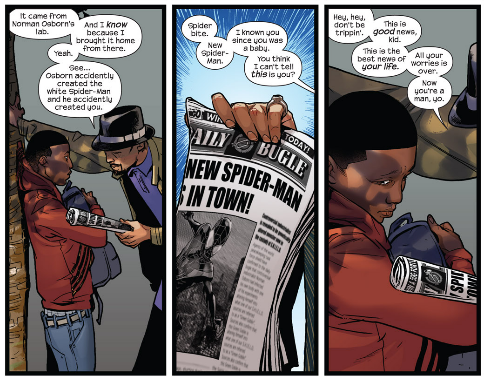
From Ultimate Spider-Man. Artwork by Sara Pichelli
Pichelli has done artwork for the Miles Morales version of Spider-Man since the first issue came out in 2011. Pichelli is able to tackle the acrobatics of a Spider-Man title with aplomb, but it’s her ability to handle the more human aspects of the comic that’s the most impressive. The first issue of Ultimate Spider-Man contains a memorable scene where Miles is entered into a lottery to get into a special school. The tension on these very few pages, filled with praying parents and tense kids, is just as high as any action sequence. One of the reasons she excels at these more human moments is her uncanny ability with facial expressions, making it easy to understand the mindset of our hero (not to mention Miles’s friends, family members, and enemies) with just one look.
Artist: Erica Henderson
Comic: The Unbeatable Squirrel Girl
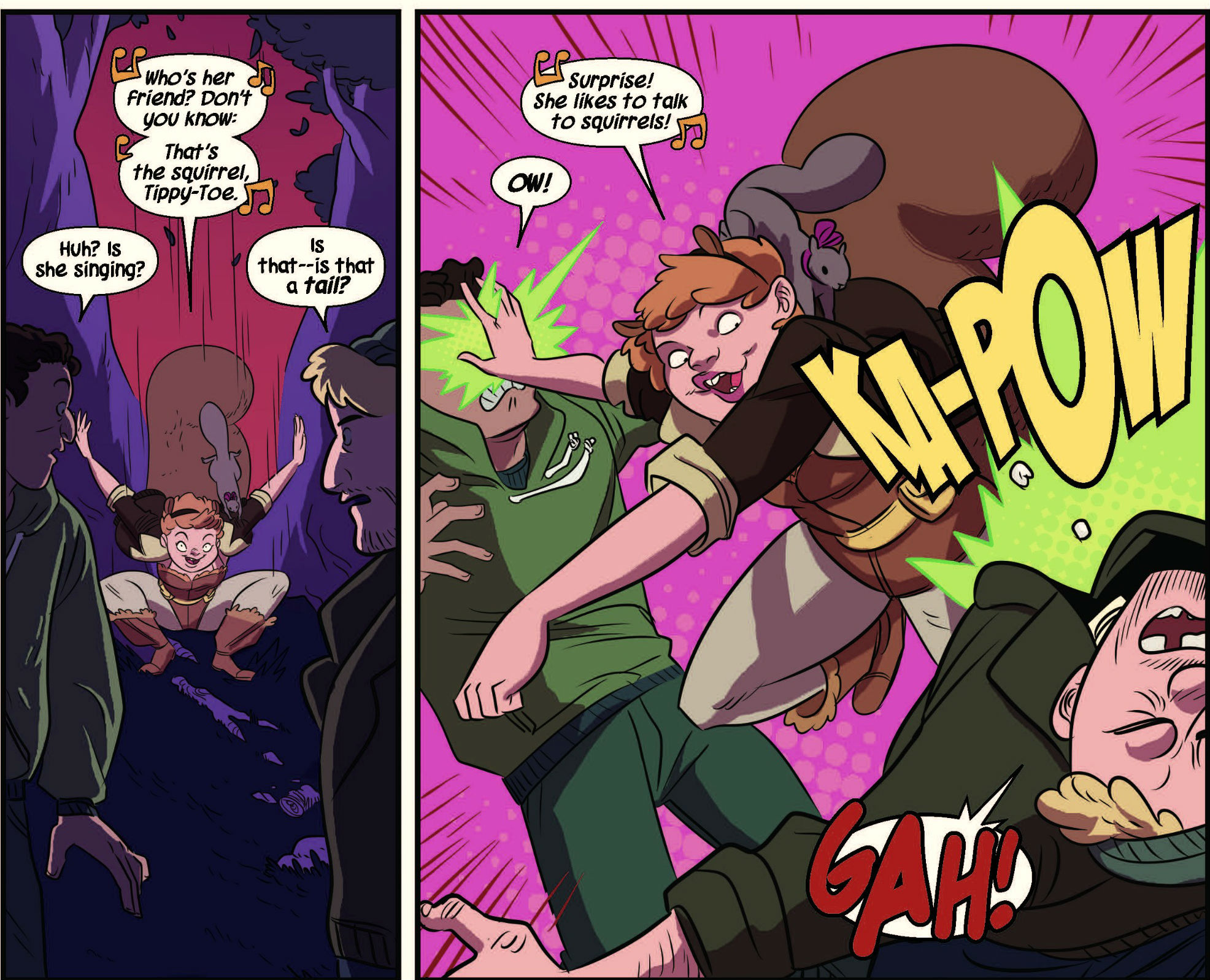
From The Unbeatable Squirrel Girl. Artwork by Erica Henderson
Seriously, could their be anyone better suited for the wacky adventures of Doreen Green then Erica Henderson? (For more on Squirrel Girl check out my article Meet Squirrel Girl: Your New Favorite Superhero, Role Model, and Best Friend). Another artist might look at the lighthearted, rodent-based title and see it as an excuse to slack off, but the art featured in these pages isn’t overly simplistic. Jokes are hidden in the background like Easter eggs, which brings the enjoyment of reading The Unbeatable Squirrel Girl to a whole other level the second time around. Also, it’s clear from reading the letter column that Henderson puts a lot of thought into her work. I couldn’t help but smile when she explained that the reason why Doreen doesn’t have a rail thin body type is because “if their powers are mostly physical… I shouldn’t be able to take down a super hero by sitting on her.”
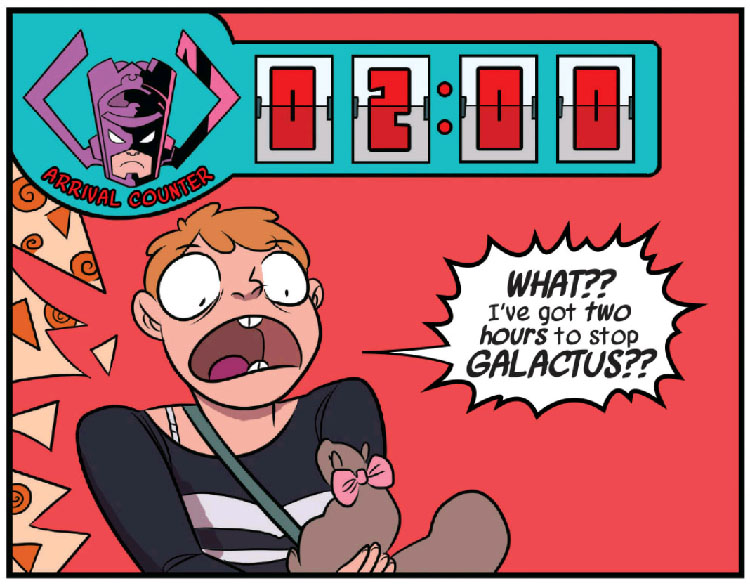
From The Unbeatable Squirrel Girl. Artwork by Erica Henderson
Of course, Henderson doesn’t take things too seriously. Squirrel Girl is meant to be a fun comic after all. Doreen’s facial expressions alone regularly have me cracking up. Henderson’s artwork sports a unique style that might not normally fit with a superhero comic put out by the big two, but it ends up working perfectly for The Unbeatable Squirrel Girl. That’s not to say that Henderson’s is inflexible though — just check out issue five, where she lampoons classic art styles.
Artist: Rebekah Isaacs
Comic: Angel and Faith: Season 9/Buffy the Vampire Slayer: Season 10
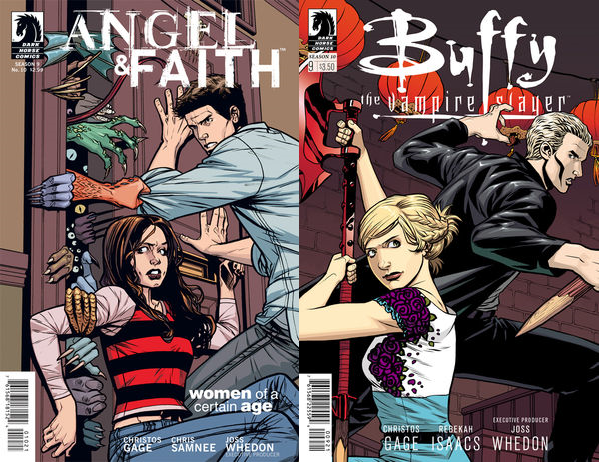
From Angel and Faith and Buffy the Vampire Slayer. Artwork by Rebekah Isaacs
Tie-in comics can be tricky. When dealing with an established television show or movie, you want your characters to resemble the actors that originally played them. But if you push too far, you risk running into uncanny valley territory. Enter Rebekah Isaacs, an artist who manages to capture the likeness of the actors from the television shows Buffy the Vampire Slayer and Angel, without sacrificing her own flavor. Angel looks like Angel because he retains the character’s stature, brown spikey hair, and wide brow. Spike looks like Spike because he sports James Marsters’s chiseled features, bleached blonde hair, and dark eyebrows. And she manages to do this all while maintaining her own visually appealing style that never flags in quality. And given that she’s been illustrating Buffy and Angel comics since 2011, that’s damn impressive.
Artist: Joelle Jones
Comic: Lady Killer
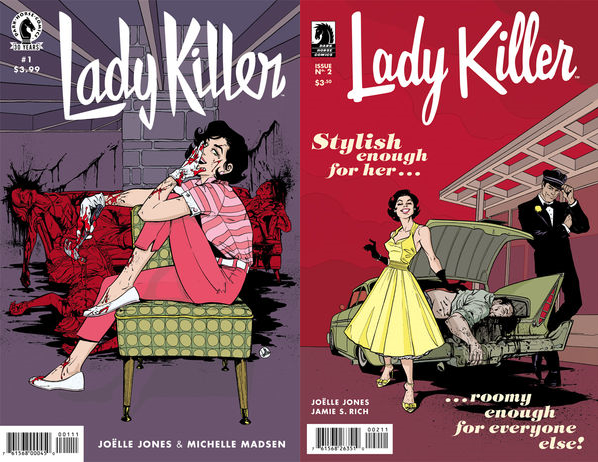
From Lady Killer artwork by Joelle Jones
Sometimes what really makes a comic work is when an artist’s particular style is perfectly suited for the story being told. Perhaps one way to guarantee this is to just have the artist write the damn thing. This can be found in Joelle Jones’s Lady Killer. Lady Killer is a period piece set in the 1960s, focusing on a well-dressed housewife who moonlights as a contract killer. And if that sounds amazing, that’s because it is. This cool factor is perfectly encapsulated by the tongue-in-cheek cover art, regularly featuring our beautiful heroine striking a model worthy pose… in front of a dismembered corpse. And the artwork on the inside is just as good. The 1960s really come to life here, from the fashion, to the cars, to the decor. And then there are the fight scenes, which are both suspenseful and brutal. This particular comic is another one that’s rather new, but I loved the first trade paperback and can’t wait to pick up the next.
Artist: Amy Reeder (also credited as Amy Reeder Hadley)
Comic: Madame Xanadu
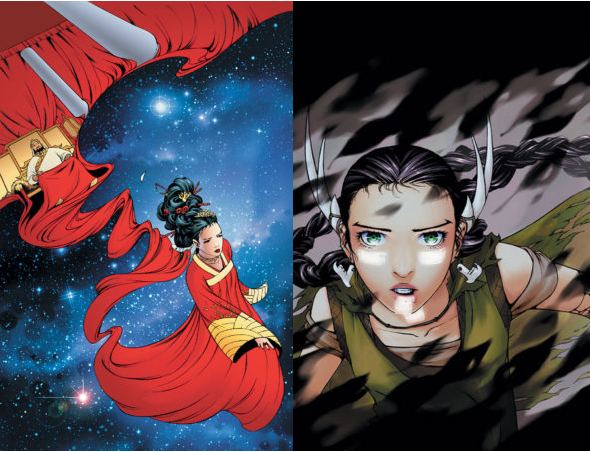
From Madame Xanadu. Artwork by Amy Reeder
I suspect every comic book reader has a few titles that they feel are criminally underrated (Greg Rucka’s Veil, anyone?). One of mine is Matt Wagner’s wonderful run on Madame Xanadu from 2008-2010, and the big reason behind that is Amy Reeder’s gorgeous artwork. Telling an origin story that goes back centuries, Reeder does a wonderful job of tackling the different looks of passing years, from the age of Camelot or the American Depression. Her art style, which has a bit of a large-eyed manga influence, is vibrant, dynamic and expressive. From simple moments of the characters standing alone, to complex double page spreads with out of this world layouts, her artwork wowed me, page after page. These days, Reeder can be found in the role of writer more than artist — working on Moon Girl and Devil Dinosaur — but she still provides some fabulous cover art.
Artist: Marjane Satrapi
Comic: Persepolis
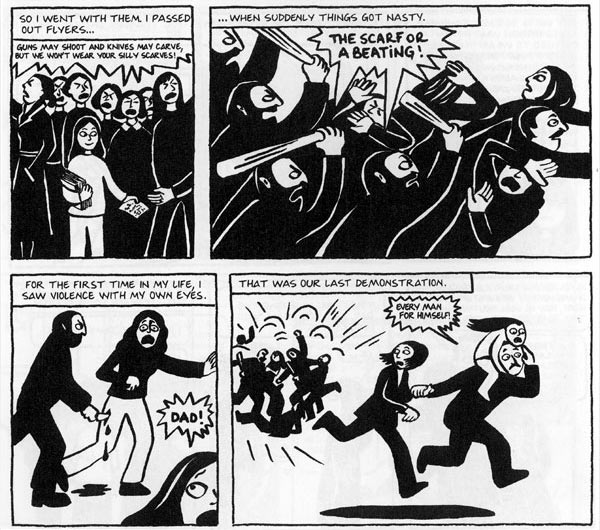
From Persepolis. Art by Marjane Satrapi
Okay, I’m breaking the rules a bit with this one, because while Marjane Satrapi’s Persepolis is a comic book, it isn’t speculative fiction. No, Persepolis is a memoir, which covers Satrapi’s life story, starting off with her childhood in Iran, and following her into adulthood. Still, it’s a truly spectacular work, and a lot of that has to do with Satrapi’s minimalist, black and white artwork, which so clearly displays the complex emotions and situations of her own life. While other artists on this list are clearly talented and worth exploring, Satrapi’s work has managed to find appeal beyond the comic book crowd. Persepolis is regularly taught in schools and universities, discussed in book clubs, and is otherwise held up as a notable work for all. Persepolis will most certainly stand the test of time and be remembered for generations to come. For that alone, it’s worth spotlighting.
***
There are so many incredible women creating art for comic books. The ones listed above are just a sample of my personal favorites. I hope you will consider giving them a chance. Also, as someone who is passionate about supporting women in comics, I am open to exploring even more! If you know of a female artist that is crazy talented, I’d love to hear about it in the comments, especially if that artist is someone that deserves more love.

I love the variety of style to be found here. I was already familiar with the first two you spotlight, so thank you for introducing me to the others!
You’re welcome! That was pretty much my (not so hidden) agenda here- introducing this artwork to new people
I want to read Monstress but this makes me a little scared, haha. The artwork is so gorgeous though. And I reaaaaally need to try Saga.
LoL. Yeah it’s a comic you need to be in the right mood to read, but it’s so worth it!
This is a great post! Love the variety. Ladykiller looks especially fun. The covers remind me of Crossgen’s defunct-but-awesome Route 66, a horror comic, which among other things always had sight gags in the covers. Might have to take a trip to the comic store this weekend.
I’ve never heard of Route 66. Is it worth checking out?